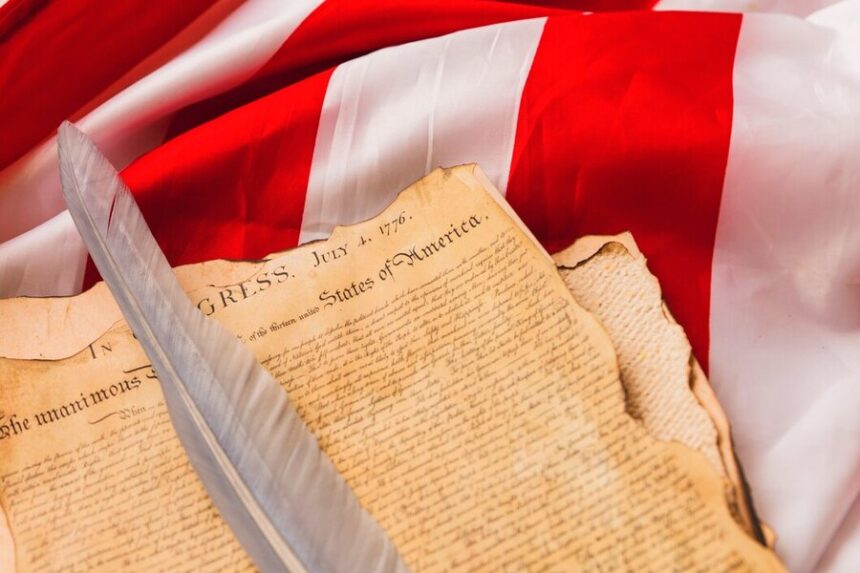The Declaration of Independence is one of the most significant documents in American history. It formally announced the thirteen American colonies’ separation from British rule and laid the foundation for the United States as an independent nation. But who wrote the Declaration of Independence? The primary author of this historic document was Thomas Jefferson, who drafted it in June 1776. However, the final document was the result of contributions from multiple figures, including John Adams, Benjamin Franklin, and the Continental Congress.
- The Primary Author – Thomas Jefferson
- The Drafting Committee and Their Contributions
- Formation of the Committee
- Role of John Adams
- Influence of Benjamin Franklin
- Contributions from Sherman and Livingston
- Final Approval by Congress
- Influences on the Declaration of Independence
- The Significance of the Declaration of Independence
- Exploring the Document’s Key Passages
- Final Thoughts
- FAQ’s
Understanding the authorship of the Declaration of Independence provides insight into the revolutionary ideals that shaped the nation. This article explores the key figures behind its creation, their influences, and the document’s lasting impact on democracy and governance.
Who Wrote the Declaration of Independence?
Thomas Jefferson was the primary author of the Declaration of Independence, drafted in June 1776. However, the document was reviewed and edited by John Adams, Benjamin Franklin, and other members of the drafting committee before being finalized by the Continental Congress. The Declaration, adopted on July 4, 1776, formally announced the American colonies’ independence from British rule, laying the foundation for the United States.
The Primary Author – Thomas Jefferson
Thomas Jefferson, a leading figure in the American Revolution, was chosen to draft the Declaration of Independence due to his eloquence and strong political philosophy. He was a key advocate for colonial independence and was deeply influenced by Enlightenment thinkers such as John Locke.
Jefferson’s draft of the Declaration emphasized fundamental human rights, including life, liberty, and the pursuit of happiness. His words reflected the colonies’ growing frustration with British rule and their desire for self-governance. Though Jefferson was the principal writer, his initial draft underwent revisions by the drafting committee and the Continental Congress before final adoption.
Jefferson’s authorship of the Declaration of Independence cemented his legacy as one of America’s founding fathers. His vision for a government based on the consent of the governed would shape American democracy for generations to come.
The Drafting Committee and Their Contributions
Formation of the Committee
The Continental Congress appointed a five-member committee to draft the Declaration, including Thomas Jefferson, John Adams, Benjamin Franklin, Roger Sherman, and Robert R. Livingston.
Role of John Adams
Adams played a significant role in advocating for independence and provided key suggestions for the document’s final version.
Influence of Benjamin Franklin
Franklin made crucial edits to Jefferson’s draft, improving its clarity and persuasive impact.
Contributions from Sherman and Livingston
While their contributions were less prominent, Sherman and Livingston helped refine the language and structure of the document.
Final Approval by Congress
After revisions, the Continental Congress officially adopted the Declaration of Independence on July 4, 1776.
Influences on the Declaration of Independence
- John Locke’s Political Philosophy: One of the most significant influences on Thomas Jefferson’s writing of the Declaration of Independence was the political philosophy of John Locke. Locke’s theories on natural rights, including life, liberty, and property, directly inspired Jefferson’s assertion that all men are endowed with unalienable rights. Locke also emphasized that governments derive their authority from the consent of the governed and that citizens have the right to overthrow any government that fails to protect their freedoms. These ideas became fundamental to the Declaration’s justification for independence.
- British Violations of Colonial Rights: A major portion of the Declaration of Independence consists of a list of grievances against King George III. The American colonists had long protested British policies, including taxation without representation, restrictions on trade, and military occupation without consent. The Declaration formally documented these violations, presenting them as evidence that the British government had failed to uphold its responsibilities to the colonies.
- Previous Colonial Declarations: Before the Declaration of Independence, various colonial assemblies had already issued their resolutions and declarations condemning British rule. Documents such as the Virginia Declaration of Rights and earlier writings by leaders like Samuel Adams influenced the language and structure of the Declaration. These earlier efforts helped unify colonial leaders in their demand for independence.
- Republican Ideals: The Declaration of Independence reflected republican principles, emphasizing representative government over monarchy. The belief that leaders should be chosen by the people rather than inheriting power was a central idea in the formation of the new American government.
- Enlightenment Thinkers: Beyond Locke, other Enlightenment philosophers played a crucial role in shaping the Declaration’s ideology. Montesquieu’s ideas on the separation of powers and Rousseau’s concept of the general will contributed to the document’s emphasis on governance that serves the people. These intellectual influences reinforced the argument that independence was necessary to establish a just and democratic society.
The Significance of the Declaration of Independence
The Declaration of Independence was far more than a formal announcement of separation from Britain; it became the ideological foundation of democratic governance. The document articulated principles of liberty, equality, and self-rule, setting a precedent for how governments should operate. By proclaiming that political power derives from the consent of the governed, it established a revolutionary framework that would inspire nations worldwide.
One of its most profound effects was laying the groundwork for future American governance. The Declaration’s emphasis on natural rights and individual freedoms influenced the development of the U.S. Constitution and the Bill of Rights. These founding documents expanded on the Declaration’s principles, ensuring protections for civil liberties, justice, and democratic participation. The concept that government exists to serve its people, rather than the other way around, became a defining characteristic of the American political system.
The Declaration’s significance extended beyond the borders of the United States. Its ideals of self-determination and resistance against tyranny inspired other revolutionary movements, most notably in France, where the Declaration of the Rights of Man and the Citizen echoed similar themes. Likewise, independence movements across Latin America, including in Mexico, Venezuela, and Argentina, drew inspiration from the American Declaration, applying its philosophy to their struggles for freedom.
Today, the Declaration of Independence remains a global symbol of democracy and human rights. Its principles continue to influence political thought, social justice movements, and governance worldwide. More than two centuries later, the document stands as a testament to the enduring power of the idea that all people are entitled to freedom and self-governance.
Exploring the Document’s Key Passages
- Preamble: The preamble serves as the introduction to the Declaration of Independence, setting the stage for why the American colonies felt compelled to sever ties with Britain. It explains the necessity of justifying their actions to the world and asserts that when a government becomes oppressive, the people have the right to overthrow it. This opening statement established the philosophical foundation for the document, making it clear that the American Revolution was rooted in the principles of justice, freedom, and self-governance.
- Statement of Human Rights: One of the most famous passages in American history, this section declares that “all men are created equal” and that they are endowed with unalienable rights such as life, liberty, and the pursuit of happiness. These fundamental rights are not granted by the government but are inherent to all individuals. This declaration directly challenged the idea of monarchal rule and emphasized that legitimate governments must protect the rights of their citizens.
- List of Grievances Against King George III: This section outlines the specific complaints against the British monarchy, detailing how King George III had violated the rights of the American colonists. These grievances included imposing unfair taxes, dissolving colonial legislatures, restricting trade, and maintaining a military presence in the colonies without consent. By listing these injustices, the document provided clear evidence of Britain’s failure to uphold just governance.
- Formal Declaration of Independence: In this section, the American colonies formally announced their separation from Britain and declared themselves free and independent states. This statement was groundbreaking because it officially severed political ties with the British Crown and affirmed the colonies’ right to self-rule. The declaration asserted that the new states had the authority to form alliances, establish trade, and govern themselves without external interference.
- Closing Remarks and Signatures: The document concludes with a strong statement of unity and commitment among the signers. The Founding Fathers pledged their “lives, fortunes, and sacred honor” to uphold their cause. By signing the Declaration, they risked their safety, as this act was considered treason against Britain. The signatures, led by John Hancock, symbolized the unwavering determination of the colonies to achieve independence and establish a nation founded on democratic principles.
Final Thoughts
The Declaration of Independence, primarily authored by Thomas Jefferson, remains one of the most significant documents in American history. It articulated the principles of liberty, equality, and self-governance, shaping the nation’s foundation and inspiring future democratic movements.
Though written over two centuries ago, the Declaration’s core message continues to resonate in modern discussions of rights and governance. By declaring that all men are created equal, the document set forth ideals that would challenge the world’s existing political structures and continue to influence global movements for freedom.
FAQ’s
Q. Who wrote the Declaration of Independence?
A. Thomas Jefferson was the primary author, with input from John Adams, Benjamin Franklin, and other drafting committee members.
Q. When was the Declaration of Independence signed?
A. It was adopted on July 4, 1776, though most delegates signed it on August 2, 1776.
Q. Why was the Declaration of Independence written?
A. It was written to formally declare the American colonies’ independence from Britain and justify the reasons for separation.
Q. How did Enlightenment thinkers influence the Declaration?
A. John Locke’s ideas on natural rights and government by consent heavily influenced Jefferson’s writing.
Q. What are the key principles of the Declaration?
A. The document emphasizes individual rights, government by consent, and the right to revolution against tyranny.




